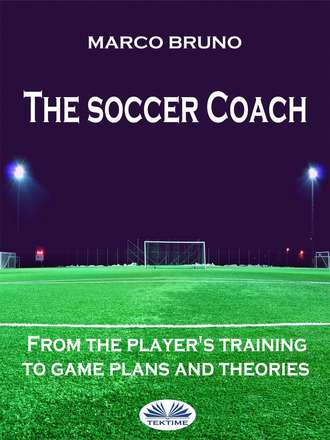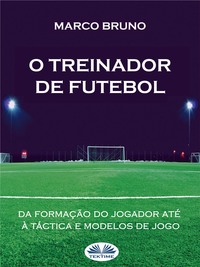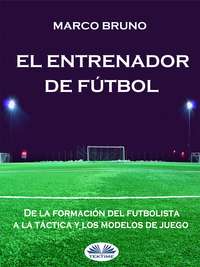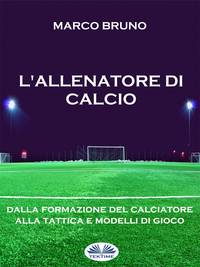
Полная версия
The Soccer Coach
PHYSIOLOGICAL EFFECTS OF TRAINING
The physical condition
The human organism can increase its functional capacities to a considerable extent through the physiological process of training.
When our body is subjected to a physical exercise of certain intensity, reactions immediately occur:
- increase in heart beats;
- increase in respiratory rhythm;
- increase in depth of breaths;
- increase of secretion of sweat.
These reactions occur regardless of the physical condition of the subject even if the latter can determine the behavior and the entity. These are temporary changes because as soon as physical exercise ceases, these changes also regress and in a short time the body returns to its normal state. The time frame for returning to normal is usually shorter, the higher the condition of the individual.
The term “physical condition” indicates the particular state for which the athlete is in the best disposition, from a physical point of view, to perform a specific performance.
One of the typical manifestations of physical condition is the removal of the “fatigue threshold”.
What is fatigue? What is the fatigue threshold?
By fatigue we mean the diminution of the functional power of an organ, or of the whole organism, due to an excess of work.
The fatigue threshold represents the demarcation limit between complete efficiency and the beginning of the decline in functional power.
The training through multiple activities aims to achieve an improvement in performance and to remove the moment of the onset of fatigue.
In practice, training manifests itself as a systematic and rational repetition of certain movements and behaviors with the aim of obtaining a performance improvement.
The structural and functional changes that occur in our body because of training, have a close relationship with the type of motor performance that has caused them: every form of movement corresponds to a type of adaptation.
In practice it happens that in the phases immediately following the physical effort, the organic and muscular structures urged to produce and support it, are not limited to overcoming the fatigue situation with a return to normal conditions, but have a reconstructive reaction that leads them to overcome the situation before stimulation.
These moments of supercompensation have a limited duration and progressively returns to the normal situation.
It is necessary to provoke other situations of supercompensation before the previous ones are completely exhausted, that is to say a “summation of the training action”(Matwejew, 1972).

The repetition of these stressful situations will cause the gradual adjustment of athletic abilities, putting the body in a position to overcome workloads with less accumulation of fatigue, or to express higher and higher performances. Supercompensation should not be understood from a physiological point of view but only as an improvement in the accumulation of glycogen.
The larger the glucose stores (glycogen stores) in the soccer's muscle, later he will feel tired and the longer he will maintain the ability to do a very high intensity job
(Cogan Coyle, 1989).
The basic element of soccer performance in terms of energy use and consumption is the running action.
The specialists were concerned to detect “what” runs the amateur soccer player during a match; in general it has been verified that this run amounts to about 8,000 meters. This would not even represent a mid-level athletic performance, if referring exclusively to the total competition time (90’).
A careful analysis of the workload, shows that within this distance are carried out:
- sprints;
- arrests and braking;
- changes of direction;
- ball controls;
- contrasts with opponents.
In other words, the soccer game is a succession of different performance for intensity type according to the game’s development and occurs within a specified period of time. Any combination of soccer performance with those of other disciplines (e.g. athletics) is really arbitrary and wrong. The soccer player from an athletic point of view is to be considered just a player and that's it. The 8,000 meters of the player's run are divided as follows:
- walk about 20% (~1.600 meters);
- slow running about 35% (~2.800 meters);
- reaches 25% (~2.000 meters);
- sprint 15% (~1.200 meters);
- backwards running about 5% (~400 meters);
Midfielders usually run higher distances than defenders and forwards. The amounts of running and the type of gait vary a lot from role to role and in the role itself in relation to the physical-athletic characteristics and above all the player's characteristics.
The distances run at maximum speed vary from 3/4 meters up to 25/30 meters, the most frequent are 10/15 meters and are repeated 50/60 times.
I also find it interesting to present the results of a study on heart rates expressed by players during a competition. The recorded values show that the player is not subject to very high tensions.
For each half of a game the following pulsating frequencies were detected:
Pulsations per minuteoffensivesMidfielders and lateral defendersCentral defender126/13111’45’’2’45’’29’00’’132/1559’45’’5’15’’29’00’’156/17312’00’’27’30’’16’00’’174/1859’00’’8’45’’0’00’’186/2042’30’’0’45’’0’00’’These figures lead to some general considerations:
1 there are significant differences between the average performance of the various players;
2 with the exception of the central defender all the other players are subjected to a wide range of stimuli;
3 in the defenders and midfielders the period of average intensity prevails while for the forwards we have the longest period of minimum intensity, but also the longest of maximum intensity.
Let us now try to analyze how movement and training can produce changes in our body. For convenience I will describe separately the effects of the movement produced on the muscles, on the joints, on the bones, on the internal organs, on the mind and also on the relationships with others, but it is necessary to keep in mind that often these effects occur simultaneously.
EFFECTS ON MUSCLES
Muscles are the active organs of movement, in fact they are made up of fibers that contract in the presence of impulses (nervous commands).The movement produces the following transformations on the muscle:
1 increase in volume: the muscle, if made to work intensely to lift weights or to overcome a resistance, becomes bigger and at the same time increases its force.
2 increase in length: the muscle maintains or increases its length by means of continuous work to which it is subjected, the muscle lengthening allows to fully exploit the joint width.
3 increased capillaries: the muscle, engaged in a work of mild intensity, but of long duration, increases its capillarization that is the number of channels that bring the oxygen (brought from the blood) to the muscle fibers. This results in an improved ability to supply the oxygen muscle: a condition that allows the muscle to resist fatigue for longer.
4 increase of energy substances: the movement allows the increase of energy substances (glycogen) necessary for muscle contraction.
5 improving the transmission of nerve stimuli: training makes the transmission of nerve stimuli from the brain to the muscles faster and more precise, thus improving the speed and coordination of movements.
EFFECTS ON JOINTS
The joints constitute the “junction” system of our body. They allow the movement of the various body segments. The articulation consists of the union of two bones whose ends are called articular heads. The movement produces the following transformations on the joints:
1 maintenance of physiological mobility: the articulation to maintain its normal mobility must be used to the maximum of its possibilities of movement.
2 increase and recovery of mobility: to recover lost mobility and increase that possessed, it is necessary to use particular forms of training and movement.
3 strengthening of the articular capsules: the joint capsule, made up of ligaments and muscles, has the task of keeping the articular heads firmly tied and to prevent the joints from getting out of place and that sprains or dislocations occur.
EFFECTS ON BONES
The bones constitute the scaffolding of our body, they fulfill the task of protection (the skull protects the brain, the spine protects the marrow) and contribute, as passive organs to the movement, to the displacement of the body and its limbs. The movement produces the following transformations on the bones:
1 better nutrition: the increased circulation of blood, caused by physical exercise, nourishes the bone tissue and supplies it with calcium.
2 development in length: the movement favors the production of new bone cells, which determines the growth in length of the bone itself.
3 development in width and thickness: the tractions on the bones, exercised by the muscles during movement, favor the development of the same in thickness and width. It follows an increase in resistance.
RESPIRATORY EFFECTS
The task of the respiratory system is to supply the body with oxygen and to eliminate carbon dioxide. The movement produces the following transformations on breathing:
1 reduction of recovery time: the trained subject takes less time to return to normal breathing after the effort.
2 minor increase in respiration rate: the trained subject, with the same work, has a lower basal respiratory rate than the sedentary (12-16 acts per minute).
3 increase in vital capacity: the vital capacity is the amount of air, measured in liters with the spirometer, which is able to emit with a forced exhalation, after having done a maximum inhalation.
4 increase of the apnoea time: the apnoea, or voluntary suspension of the breath, increases in duration in the trained subject.
5 strengthening of the respiratory mechanics: the respiratory muscles, and in particular the diaphragm, with the exercise increase their power and the efficiency of their contractions.
EFFECTS ON THE HEART AND CIRCULATION
The circulatory system consists of the heart (pump), the great circulation (arteries and veins that carry blood to the various tissues, the organs of the body and bring it back to the heart), the small circulation (which brings blood to the lungs to oxygenate them and brings it back to the heart).Physical activity produces evident effects on the cardio-circulatory system, among these the most expressive are:
1 the shape of the heart changes: the heart of an athlete becomes almost spherical.
2 the heart becomes thicker: the internal cavities (atriums and ventricles) increase in volume and the muscular walls thicken.
3 the systolic range increases: the amount of blood expelled at each contraction (systole) of the heart is greater because the internal volumes and muscle strength have increased.
4 cardiac output increases: the amount of blood put into circulation in one minute.
5 heart rate increases: the number of pulses per minute increases during work. Remembering that with the same work, the trained subject will have a lower number of pulsations thanks to the capacity of his heart to pump a greater quantity of blood.
6 reduction of the pulsations at rest: this is one of the most easily controllable effects, but it is achieved only thanks to constant and prolonged training.
7 reduction of recovery time after exertion: the trained subject returns more quickly to the cardiac rhythm of rest than the sedentary subject.
8 increase in the capillaries of the heart: the heart is better sprayed and better nourished.
9 increase of the capillaries in the muscles: the opening of new channels of blood circulation is important to improve the nutrition of the muscles and to eliminate more quickly the slags produced by the muscular contraction.
10 blood rerouting: when engaged in intense physical work the blood is channeled to the muscles engaged and is subtracted from other sectors. They are mainly the intestine, the stomach, the liver and the spleen to give blood for muscle work. For this reason, those who are poorly trained, accuse pain in the right or left side.
11 facilitating the return of blood to the heart: during movement, the muscles, with their contraction, “massage” and “squeeze” the veins that, thanks to the dovetail valves, convey blood towards the heart.
EFFECTS ON DIGESTIVE FUNCTION
Physical exercise accelerates all digestion, from mechanical to chemical and secretive. Exercise strengthens and speeds up stomach and bowel movements.
EFFECTS ON THE NERVOUS SYSTEM
The Central Nervous System (CNS) consists of:
- brain;
- cerebellum (balance);
- brain stem;
- spinal cord.
The Peripheral Nervous System (PNS) consists of:
- 12 pairs of cranial nerves;
- 31 pairs of spinal nerves;
- sympathetic system (regulates heart beats, respiratory acts, blood pressure);
- parasympathetic system (regulates the digestive system and balances the reactions caused by the sympathetic system).
Movement is the most visible act produced by the nervous system: it is the motor response to nervous excitement.
In order for the movement to take place, three phases are necessary:
1) information;
2) processing;
3) knowledge.
After receiving the information (kicking the ball) an ideomotor scheme is created using the memory of similar movements already performed previously. Once the schema has been prepared, the brain produces the nerve stimuli suitable for making the right muscles contract with the right force and in the correct sequence. In the voluntary movement, especially if never done before, the times related to the three phases will be long. When the movement has already been repeated several times, it becomes automatic because the motor scheme is already known and ready; the execution of the gesture becomes faster and more precise; motion control has been automated. Therefore the motor exercise trains and educates the sensory organs, improves and sharpens the visual, auditory, tactile, proprioceptive (ability to analyze the position of our body with eyes closed) and balance.
PSYCHIC AND SOCIAL EFFECTS
Motor activity develops:
a) cognitive ability;
b) the imaginative capacity;
c) practical capacity.
The motor activity improves:
a) attention;
b) the memory.
When you are preparing to do a sports exercise, you behave like when you are preparing to understand a concept, to grasp a truth, to solve a math problem. First the data are brought into focus, that is to say, what is available and the objectives to be achieved; then the difficulties to be overcome are analyzed; then it is reflected and moves on to action; and finally, the results are checked and their accuracy checked. It is easy to understand how sport stimulates our emotional states and our passions (joy, enthusiasm, satisfaction, pride, etc.).Sports activity helps those who have problems of shyness and insecurity because they are used to courage and trust in themselves.
SOURCES FOR ENERGY PRODUCTION
Muscle fibers
It is known that the quality of the contraction of a muscle depends, essentially, on the percentage of the type of fibers that compose it. The endowment or the percentage distribution of the different muscle fibers is genetically determined
(Weineck 2001).
There are two main types of muscle fibers:
Red type I fibers, thin and slow called ST (slow twitch = slow-twitch fibers).These fibers intervene in low-intensity muscular work (high oxidative capacity, low glycolytic capacity).Their capillarization is 4.8 capillaries, on average, per fiber.
White type II fibers, clear, thick and rapid called FT (fart twitch = fast-twitch fibers).These fibers come into action in intense muscular stress and rapid force. Their capillarization is 2.9 capillaries, on average, per fiber.
There are three sub-categories of FT fibers, namely:
1 Type IIa fibers (oxidative-glycolytic capacity);
2 Type IIb fibers (high glycolytic capacity);
3 Type IIc fibers (high oxidative capacity and good glycolytic capacity, also called intermediate fibers).
According to some research, champion athletes enjoy a genetic privilege. The research has discovered a DNA gene called "alpha-actinin-3" that controls the production of actinin in muscle, a key constituent of fast-twitch fibers. The alpha-actin-3 gene exists in two main alternative forms, called “alleles”, given as a gift by each of the parents, which can be the same or different, can be presented with a double pair
of RR alleles, determine the presence of the sprint protein in the muscle;
of XX alleles, do not command the production of actinin;
of RX alleles, partial actinin production, majority of the population
Конец ознакомительного фрагмента.
Текст предоставлен ООО «ЛитРес».
Прочитайте эту книгу целиком, купив полную легальную версию на ЛитРес.
Безопасно оплатить книгу можно банковской картой Visa, MasterCard, Maestro, со счета мобильного телефона, с платежного терминала, в салоне МТС или Связной, через PayPal, WebMoney, Яндекс.Деньги, QIWI Кошелек, бонусными картами или другим удобным Вам способом.








